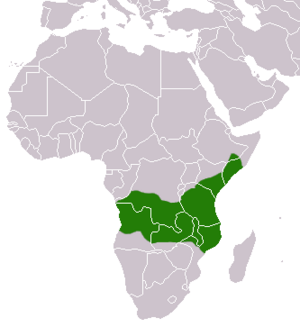Yellow baboon facts for kids
Quick facts for kids Yellow baboon |
|
|---|---|
 |
|
| Conservation status | |
| Scientific classification | |
| Genus: |
Papio
|
| Species: |
cynocephalus
|
 |
|
| Distribution of yellow baboon | |
| Synonyms | |
|
Simia cynocephalus Linnaeus, 1766 |
|
The yellow baboon (Papio cynocephalus) is a type of baboon that belongs to the Old World monkey family. Its scientific name, cynocephalus, means "dog-head" in Greek. This is because their faces and muzzles look a bit like a dog's.
Yellow baboons have slender bodies with long arms and legs. Their fur is a yellowish-brown color. They look similar to the chacma baboon, but they are a bit smaller. Their faces have no hair and are black, with white fur around the sides, like sideburns.
Male yellow baboons can grow to about 84 centimeters (about 33 inches) tall. Females are smaller, reaching about 60 centimeters (about 24 inches). They have long tails that are almost as long as their bodies. In the wild, yellow baboons usually live for about 15 to 20 years. Some can even live up to 30 years!
Contents
Where Do Yellow Baboons Live?
Yellow baboons live in the savannas and open forests of eastern Africa. You can find them in countries like Kenya, Tanzania, Zimbabwe, and Botswana. They are active during the day and spend most of their time on the ground.
These baboons live in large, mixed-gender social groups called troops. A troop can have anywhere from 8 to 200 individual baboons.
What Do Yellow Baboons Eat?
Like all baboons, yellow baboons are omnivorous. This means they eat both plants and animals. They especially love fruits. Their diet also includes plants, leaves, seeds, grasses, and tree bark.
They also eat small creatures like worms, insects, spiders, and scorpions. Sometimes, they even hunt birds, rodents, and other small mammals. Baboons are very good at finding food and will eat almost anything they can find.
Yellow Baboons in Their Environment
Yellow baboons play an important role in their ecosystem. They are a food source for larger predators, helping to keep the food chain balanced. They also help spread seeds when they eat fruits and then move around. Their messy eating habits also help to scatter seeds.
Baboons are also good hunters of smaller animals and their young. This helps control the populations of these smaller creatures.
How Baboons Adapt to Change
Baboons are very adaptable animals. They can live in many different environments, even places where other animals might struggle. This includes areas that have been changed by human settlements. Because of this, they are one of the most successful primates in Africa. They are not currently considered an endangered species.
However, their ability to adapt sometimes causes problems with humans. When baboons raid farms for crops or livestock, they are often seen as pests. This has led to projects to control their numbers in some areas. But as their natural homes shrink, more and more baboons are forced to move closer to human areas.
Types of Yellow Baboons
There are two main types, or subspecies, of the yellow baboon:
- Papio cynocephalus cynocephalus (this is the typical yellow baboon)
- Papio cynocephalus ibeanus (Ibean baboon)
Baboon Behavior and Communication
Yellow baboons use at least ten different sounds to communicate with each other. When a group of baboons travels, the male baboons usually lead the way. The females and young baboons stay safely in the middle of the group. Less dominant males follow at the back.
The social order within a baboon group is very important. Some baboons have learned clever ways to avoid fights. For example, a male baboon might pick up a baby baboon and hold it up like a "passport" when approaching another male. This often calms the other male and allows the first male to get closer safely.
Social Life and Health
Scientists are studying how the social habits of yellow baboons affect their gut microbiome. The microbiome is the community of tiny living things, like bacteria, that live inside their bodies. Researchers have found that how much baboons interact with each other can change their microbiome.
This might happen through accidental sharing of germs during grooming, even though baboons don't eat poop. This kind of sharing is especially important for germs that can't survive long outside the body. Another study found that when male baboons move to a new group, their gut microbiome changes. They might get new microbes from their new diet and from social interactions like grooming.
Gallery





